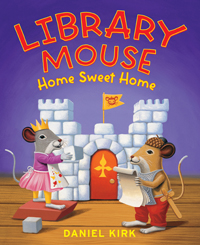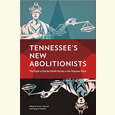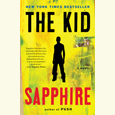Give a Mouse a Book, and He’ll Build You a Yurt
Daniel Kirk, creator of Library Mouse, considers the value of children’s literature
Daniel Kirk continues his popular picture-book series with Library Mouse: Home Sweet Home, a story in which Sam and Sarah look for a new place to live while their library home is undergoing renovations. With some research and teamwork, they build a series of houses in the library attic, including a yurt, an igloo, and a castle. But none can make Sam feel at home, and Sarah tells him, “You’ll always be a library mouse, Sam, no matter what kind of house you live in.” Kirk’s illustrations will engage children as they learn about different kinds of houses. And readers of all ages will identify with both Sam’s need for the familiar and Sarah’s love of adventure. Daniel Kirk recently answered questions from Chapter 16 by email about Sam and Sarah, his writing process, the beauty of research, and his dream house.
Chapter 16: Sam likes his world to be cozy and safe. Sarah likes adventures. Which mouse most closely resembles you?
Daniel Kirk: I think Sam and I have a similar sense of style. He wears a size extra-extra-extra-extra small, though, while I wear large. I like Sarah’s bomber jacket, and wish I had one, but you’ll never get me in a pink tutu! Actually, all the characters I make up are part me and part invention. I am a little shy and reclusive at times, but I do like an adventure once in a while.
Chapter 16: What is the most interesting response you’ve had from a young reader?
Kirk: I feel like I have done my job when my readers think my characters might be real. Kids are always asking me where Sam really lives, and if he can really talk. And write books. I always answer, of course, yes. And there just may be a library mouse hiding in every library.
 Chapter 16: Besides being fun to read, the Library Mouse books seem tailor-made for classroom activities. What are some of the best activities you’ve seen based on one of your books?
Chapter 16: Besides being fun to read, the Library Mouse books seem tailor-made for classroom activities. What are some of the best activities you’ve seen based on one of your books?
Kirk: Recently I visited a school where all of the kids had built little dioramas of Sam’s hole in the wall. The displays had tiny bookshelves, TV sets, beds, couches, and writing desks. Activities like this give kids a chance to really envision what kind of home a character might have and let their imaginations go wild in decorating it.
Another good one was when the children had to make up lists of Sam’s favorite books in the library. This is a little lesson in empathy and understanding, and it was funny to see how kids would pick out different themes or genres that Sam might like. Books about libraries, for sure, books about mice, books about being shy. Boys often suggest books about football and baseball for Sam to read. I guess they figure he ought to be a little more sporty! Of course, Sam loves all books.
Chapter 16: Eric Carle said, “If you are a novelist, I think you start with a twenty-word idea, and you work at it and you wind up with a 200,000 word novel. We, picture-book people, or at least I, start out with 200,000 words and I reduce it to twenty.” Same for you?
Kirk: Wow! I start out with a simple concept in mind. I have to think of a decent ending for my story before I start writing. Since I make illustrations for my books as well as write them, I must work on the sketches and the words at the same time, to make sure both parts are doing their job in telling the story with clarity and simplicity. And yes, I do edit a lot of my first, second, and third drafts to get rid of stuff that isn’t necessary to telling my story. I have written novels, too, and I am sorry to admit that my first novel started off at over a thousand pages. I had to cut it by half to get it into publishable shape. It took me the better part of a year. Since then, I have been learning to be a little economical with my word count, because it hurts to take out stuff I thought was good. But it must be done, or you exhaust yourself and your reader, too.
Chapter 16: You write on your blog that you loved to read comic books as a child. Are there any elements of your writing today that can be traced to the influence of comic books?
 Kirk: I would say that comic books were appealing to me because they told stories with both words and pictures. I always thought that was an ideal situation for storytelling—and gave me more to appreciate when I spent my entire allowance on comics. I could see that both the writer and illustrator were heavily involved in bringing imaginary worlds to life. Picture books do the same thing, but for a somewhat younger audience.
Kirk: I would say that comic books were appealing to me because they told stories with both words and pictures. I always thought that was an ideal situation for storytelling—and gave me more to appreciate when I spent my entire allowance on comics. I could see that both the writer and illustrator were heavily involved in bringing imaginary worlds to life. Picture books do the same thing, but for a somewhat younger audience.
Chapter 16: You were part of the first all-school event at Sandy Hook Elementary after the shootings. Besides allowing kids to hear stories, sing, and have fun, is there any other role literature can play in helping children to cope with cataclysmic events?
Kirk: I think that the best books give us a dose of escapism as well as insight into ourselves—they remind us as readers that the world is a big place, that our own problems can be put into perspective, and that life is all about learning from our joys as well as from our suffering. The best literature shows us that there are endings while reminding us that there are always new beginnings. Good books help us see that there are other people out there who understand what we’ve been through, and they can tell us what they learned.
b>Chapter 16: In this book, Sam needs a new house while the library is being renovated. He immediately turns to books. Then he acts on what he’s learned. And when he’s not quite pleased with the results, he does more research. (A nice synopsis of the research process.) What message would you like children to take away about research from this book?
Kirk: Research is one of the most important parts of creative work—and that includes writing fiction. If an author is going to make a believable story, the world in which the story takes place has to be convincing. So I always do a ton of research. Once in a while it may seem dull, but most of the time, research is fun. I like learning and discovering new things, so research allows me to learn while I work. It’s a good combination.
Chapter 16: You’ve written series as well as stand-alone books. How did you decide that Sam the Library Mouse had more than one story to tell?
Kirk: After the first Library Mouse book came out, I realized that people liked my story because it encourages kids to think of themselves as authors, that they can write, that they have stories to tell. When the book sold well, I was asked to write a sequel. All five books are about the power of imagination, facing obstacles, the joys of exploring and trying something new. I like getting the chance to explore my characters in greater depth, to introduce new characters and situations that involve things related to what writers do in real life. The second book was about how authors and illustrators work together, the third was about using research to overcome fears, and the fourth was about how art can bring strangers together. The new book is all about exploring what it means to have a home—all in the context of a library, where it is easy to do research and explore the world without ever having to leave your comfortable place.
Chapter 16: Finally, if you could live in any of the houses that Sam and Sarah built, which one would it be?
Kirk: I just love the sound of the word “yurt.” But yurts are kind of small, and I have a lot of stuff. I also need a big place to work, so I would probably want a yurt village all for myself—and my family and friends, too, of course, if I could talk them into it!
Daniel Kirk will discuss Library Mouse: Home Sweet Home at the twenty-fifth annual Southern Festival of Books, held in Nashville October 11-13, 2013. All festival events are free and open to the public.





